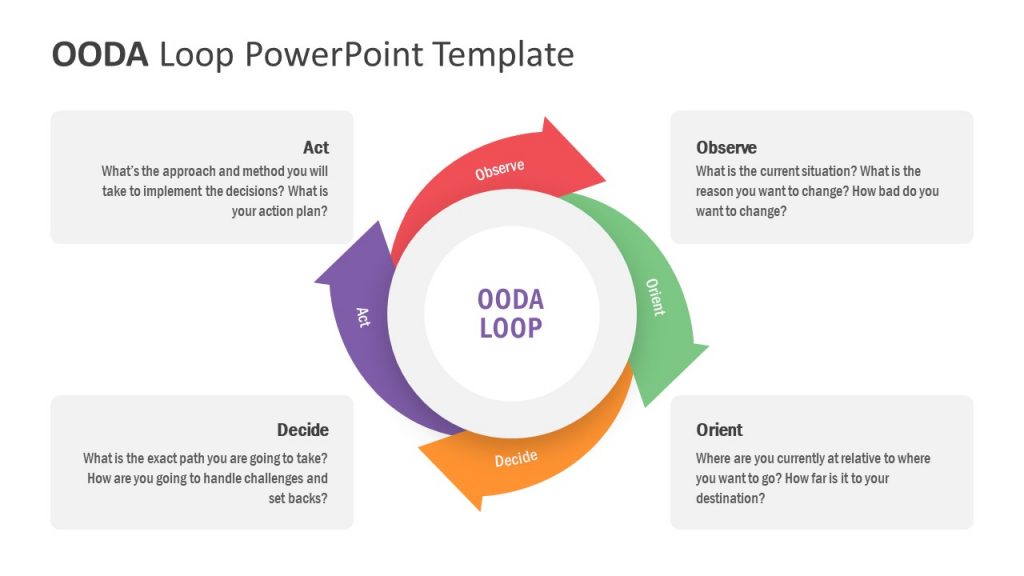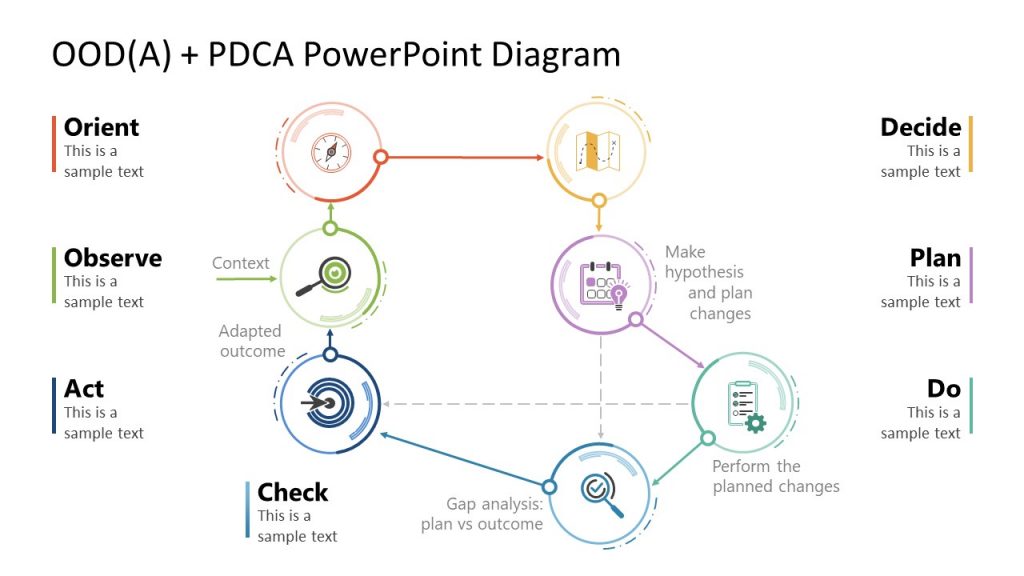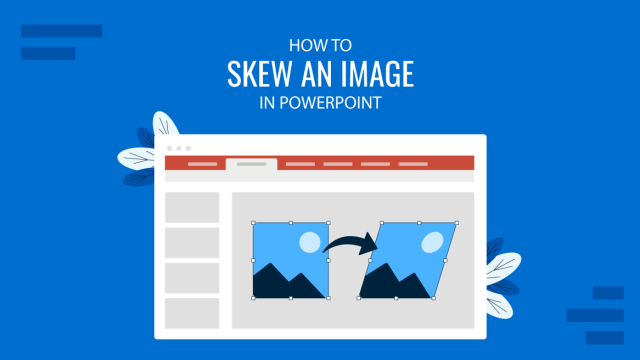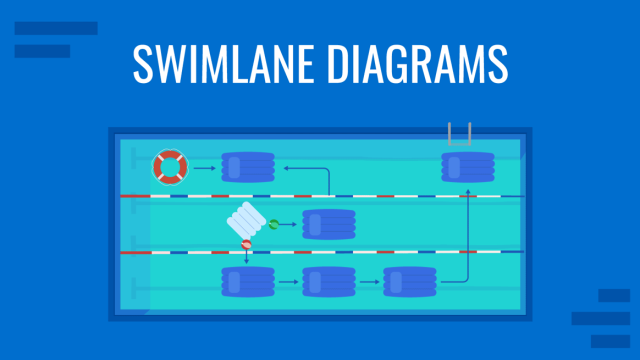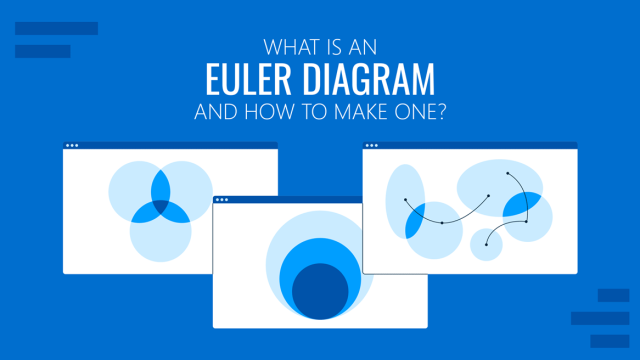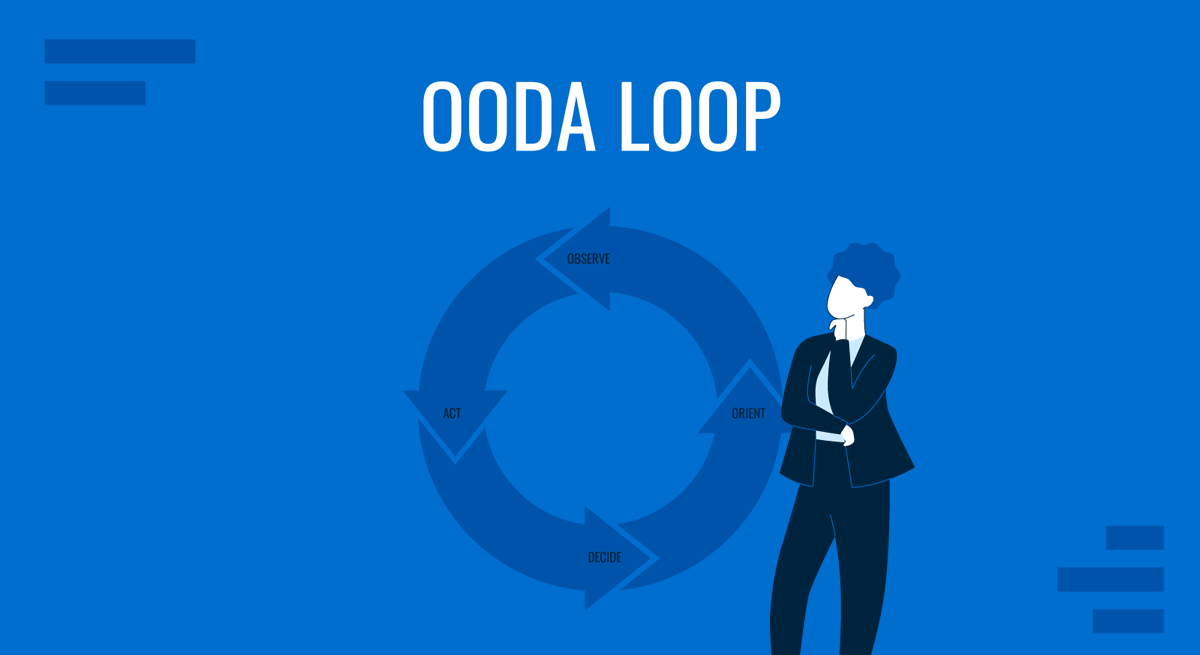
In businesses, decision-making can be slow and complicated sometimes. The way decisions are made leads to missed opportunities and higher costs. The OODA Loop is a helpful tool that improves the decision-making process by speeding up decision time. Presenters should be familiarized with the practical application of the OODA Loop in terms of expressing a decision process in business strategy presentations or any kind of critical decision path.
By incorporating the OODA Loop, professionals can ensure clear communication by continually observing and adapting to audience reactions. In turn, presentations are perceived as more engaging and impactful, with an audience-centric delivery. In this article, we will introduce this tool and how to properly apply it to presentations through some real-world examples.
Table of Contents
- What is the OODA Loop?
- The Four Phases of OODA (Observe, Orient, Decide, Act) in Presentations
- Iterative Nature of the OODA Loop
- Benefits of Using the OODA Loop in Presentations
- Using OODA Loop for Countering Business Competitors
- Enhancing Decision-Making and Adapting to Rapid Change through the OODA Loop
- Business Applications of the OODA Loop: Competitive Analysis and Strategy
- Real-world Applications of the OODA Loop in Presentations
- Real-Life Examples of the Usage of the OODA Loop in Business Strategy
- Common Challenges in Applying the OODA Loop
- Criticisms and Limitations of the OODA Loop
- Recommended OODA Loop PowerPoint Templates
- Final Words
- References
What is the OODA Loop?
In the mid-1950s, USAF Colonel John Boyd introduced the OODA Loop strategy. It is a concept of situational awareness [1]. It was adopted by Western militaries and applied in business, as seen in companies like Dell and Scotts Miracle-Gro.
Pullen (2014) describes an OODA Loop definition like: “The OODA Loop as a 4 Phase process of how someone collects information on what is happening. He understands it, decides on an action, and then takes that action” [2]. This decision-making process is dynamic and responsive because the actor gets feedback on what happens. This leads to new decisions. It is a sequence with continuous observation and orientation, even if decisions and actions are distinct.
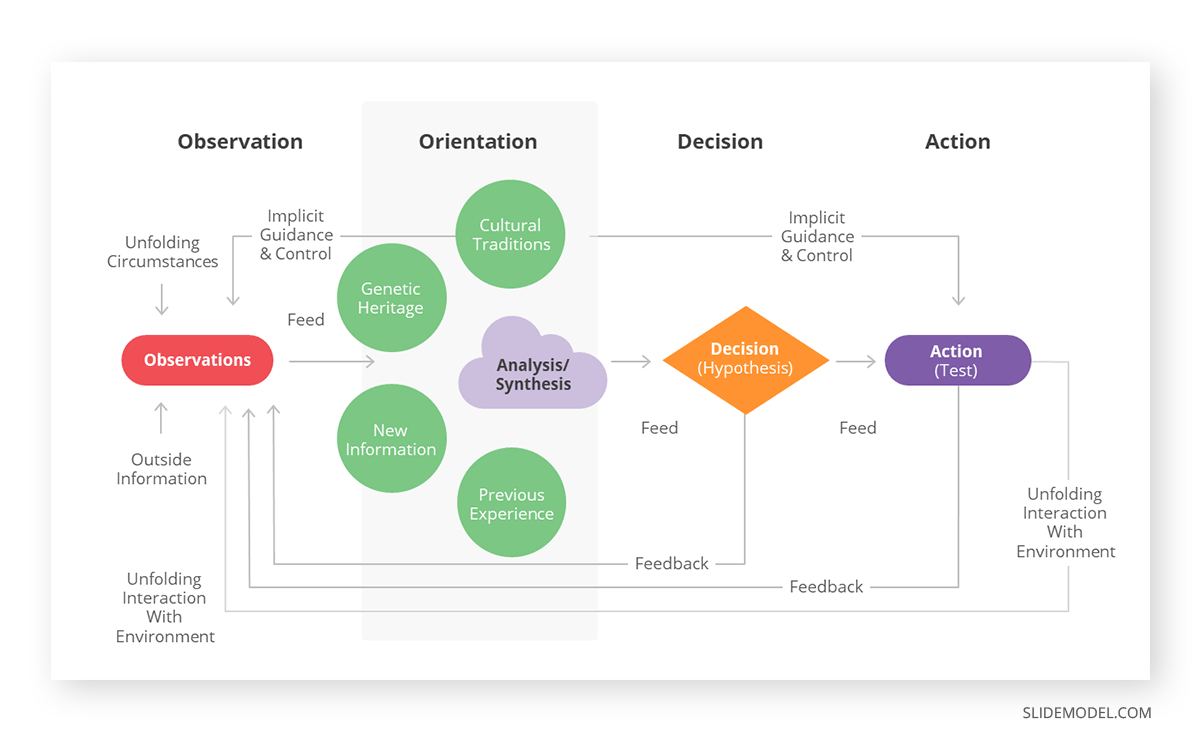
The Four Phases of OODA (Observe, Orient, Decide, Act) in Presentations
The OODA Loop decision making model is a cycle that consists of four key stages.
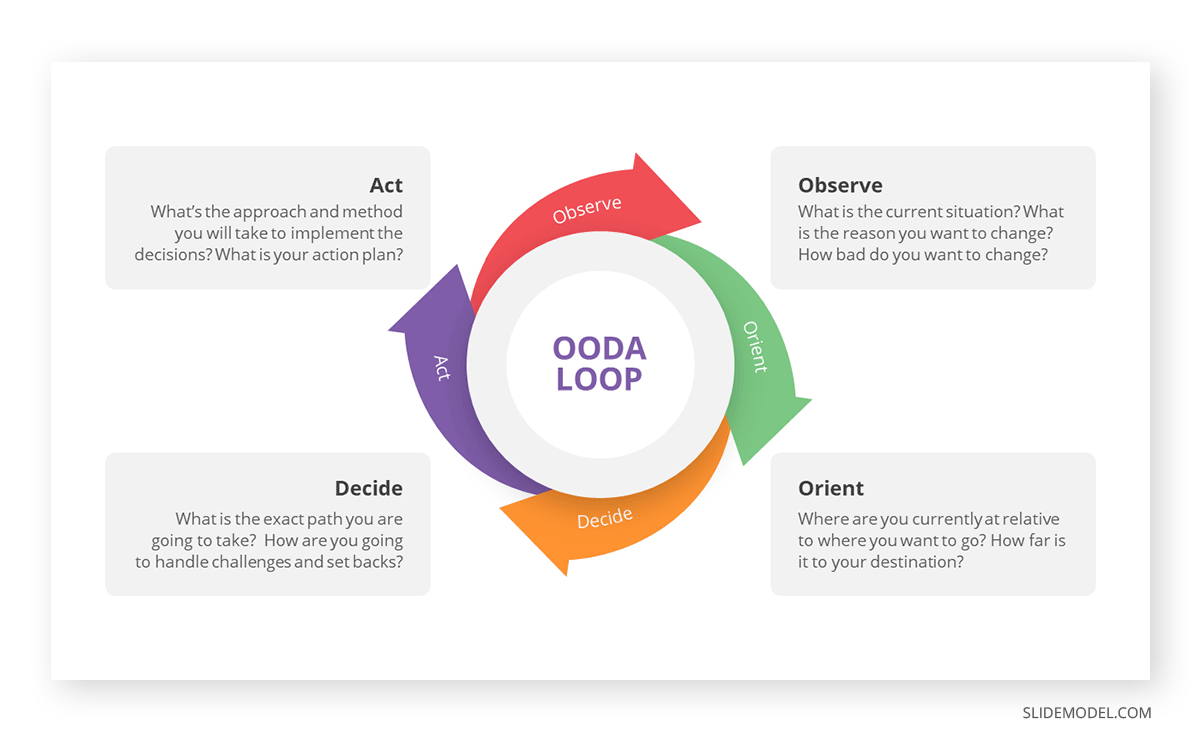
Observe: Gather Information
This initial phase of OODA Loop is about actively gathering information about the current situation through a streamlined approach. The presenter explores various sources of information to give in-depth insights into the topic [9]. The use of both internal and external sources can be beneficial. At the same time, staying updated on current trends and developments improves the information quality. In the process, the most relevant information is focused on while filtering out extra details. An in-depth understanding of the audience and their preferences also improves the information quality.
Observing requires paying attention to relevant details, identifying patterns, and staying aware of environmental changes [3]. A quality of observation will help in information processing, which is the next phase in OODA Loop.
We can use various techniques for effective observation such as visual sense, supplementary documents, audience feedback, contact, and research on the context [10]. These methods provide factual insights into areas that require additional clarification during the presentation.
Orient: Analyzing and Contextualizing
The second “O,” orientation, refers to our collective knowledge base, including past experiences, education, tradition, biases, and cultural heritage. This is influenced by our analytical and synthetic abilities. Orientation guides how we observe, decide, and act. In the Orient phase, the gathered information is processed, filtered, and interpreted [4].
Orienting the presentation to the specific context ensures its alignment with the audience’s needs [8]. A sales pitch may focus on product benefits and market positioning, whereas a training presentation may emphasize skill development.
Effective orientation strategies include creating a clear presentation structure, focusing on key points, and providing relevant context [11]. Whenever reliable sources for collecting and processing the data are used, the quality of the presentation improves.
Decide: Making Informed Choices
After observing and orienting, the decision-maker moves to the Decide phase. He finds out how to respond to the gathered information in this phase. This phase usually offers three options for decision-making [3]. The first option is to act immediately if the observation needs quick action. The second option is assessing the situation if further research is needed to evaluate minor events or not. The last option is doing nothing if the information has little impact on the overall outcome so that resources can be preserved for more relevant applications [3].
Decision-making in structuring the presentation involves determining the logical flow of information. Effective decision-making in content prioritization ensures that key messages are highlighted. In a marketing presentation, prioritizing unique selling points or competitive advantages can significantly influence audience perception. Decisions are influenced by prior experiences, cognitive biases, misinformation, time limitations, and topic complexity [12].
Act: Implementing Decisions
The final stage is Action, where the decision is implemented. Acting is executing the chosen course of action swiftly and effectively [4]. Action in presentation delivery would be efficient communication abilities, like vocal adjustment, body language, and slide pacing.
The 4 phases of the OODA Loop—Observe, Orient, Decide, and Act—are interconnected in a continuous process. Completion of one OODA Loop initiates a new cycle [5]. The actions taken in the previous OODA Loop process become new observations, feeding back into the loop. The endless feedback loop ensures that this decision-making process adjusts to changing situations. The connectedness of these phases helps organizations to assess challenges and respond rapidly.
Applications in the Corporate World for Decision-Making
Beyond its military roots, the OODA Loop has become a valuable tool for business professionals. The OODA Loop gives a structured approach to decision-making in various business operations. Like the scientific method, it is an iterative process catering to challenges and opportunities. The OODA Loop allows businesses to rapidly observe changes in the market and orient themselves to evolving conditions [6]. So they can make timely decisions and execute actions. The OODA Loop’s simplicity makes it a valuable tool for evaluating uncertainties and making informed decisions [7].
Other than that, the OODA Loop also improves business presentation design and delivery. Staying well-informed of design and communication trends is depicted through visually appealing elements and multimedia tools in the presentation.
Iterative Nature of the OODA Loop
The OODA Loop continually repeats itself, creating a dynamic and adaptive decision-making process. After completing the “Act” phase and implementing decisions, the loop doesn’t terminate. Instead, it seamlessly transitions back to the “Observe” phase. With the ongoing actions, individuals or systems continuously gather new information from the environment. As the cycle repeats, the outcomes of previous actions become new observations [3]. These observations feed the Orient phase, where the information is analyzed based on the evolving situation. Subsequently, it leads to a new set of actions.
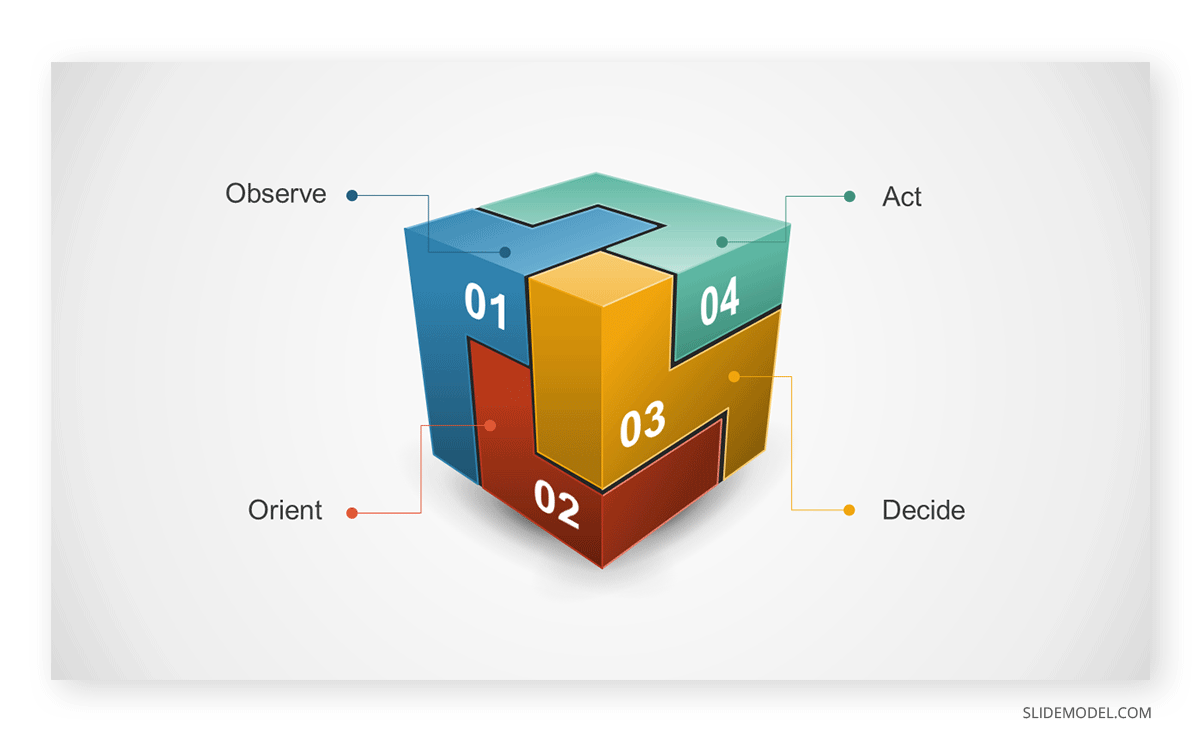
The cyclical nature shows that the decision-making process is not static. It remains in a continuous process of reassessment and development. This iterative nature of decision-making demands continuous adaptability. Repeating stages like understanding the target outcome and gaining situational awareness refine responses. Continual practicing of situational awareness ensures proactive and responsive decision-making. Iteration in decision-making helps to incorporate new details and real-time adjustments [4]. This ongoing cycle also facilitates self-assessment, determining progress, and assessing the decision’s effectiveness.
Benefits of Using the OODA Loop in Presentations
Audience-Centric Adaptations
The OODA Loop allows presenters to quickly adapt and deliver content based on immediate audience reactions. It ensures that the presentation is engaging and resonates effectively with the context.
Dynamic Storytelling
Presenters can use the OODA Loop to adjust the narrative flow. It helps in responding to audience preferences in real-time. It will develop a more compelling approach.
Responsive Q&A Sessions
During question-and-answer sessions, the OODA Loop will help presenters to answer quickly. Speakers who use the OODA Loop provide well-informed responses and maintain an interactive presentation environment. This helps to build a stronger connection with the audience.
Agenda Management
Using the OODA Loop, presenters adjust the presentation agenda by prioritizing topics that align with audience interest. It takes a quick time to develop a plan using the OODA Loop decision-making model.
Tailored Engagement Strategies
Presenters employ the OODA Loop to customize engagement strategies. They adjust their approach to various audience segments, improving audience interest.
Improved Handling of Unexpected Situations
The OODA Loop also helps to handle unexpected disruptions or technical issues swiftly. It helps to minimize disruptions and maintain audience focus on the key message. Moreover, anticipating potential challenges or questions and planning for them improves your ability to handle unexpected situations during the presentation.
Facilitates Iterative Learning
The OODA Loop promotes an iterative learning process for presenters. It helps them continuously refine their approach based on audience feedback and experiences, improving their presentation skills.
Using OODA Loop for Countering Business Competitors
OODA Loop in business is all about revising business strategies by working in a loop of observing, orienting, deciding, and acting upon the decision taken in light of recent developments. Keeping business strategies relevant can help businesses adapt to competition and counter competitors. For example, Responsive websites now allow websites to be navigated with ease across mobile devices, targeting a large chunk of mobile users who have moved away from a desktop environment.
Businesses selling products and services online or using the Internet for advertising must adapt to such an environment to stay relevant. Companies that are slow to understand such trends end up losing market share to competitors who are efficient in identifying and using these subtle changes in the business landscape.
What businesses need to understand under the concept offered by this decision-making model is that they need to have the ability to be flexible. The process itself is iterative and repetitive. New developments can easily change the business’s needs to stay relevant in a matter of days once new technology or trends begin to pick up.
Observe
The first step in OODA Loop is to ‘observe.’ This includes gathering as much information as possible to acquire data that can be rationally interpreted to observe the current business environment. By analyzing the external and internal environment, businesses can look for changes that might affect them. Recording the findings from these observations might be a key process, perhaps creating a PowerPoint presentation where the decision-makers can start collecting insights.
Example: The exchange rate of a developing country might alter to depreciate the national currency value against the U.S. Dollar, making imports expensive with a need to raise prices. However, some competitors might find a workaround by reducing imports and relying on raw materials from more affordable sources available within the country. This might signal to opt for the most cost-effective business strategy to counter competition before a business loses market share. Similarly, observing past and present market forecasts might help a company make better decisions. If the exchange rate is likely to stabilize, it might not be feasible to opt for local alternatives if they are low quality. This might give the business a competitive edge in producing a better product in quality, with relatively inelastic market demand.
On the contrary, if the exchange rate is likely to remain volatile, a business might opt to make alternative arrangements. They can set up operations to produce some spare parts locally to maintain quality standards and outsource some raw materials to local firms that can ensure international standards. Another option would be to set up joint ventures or transfer technology to local businesses to meet specific quality standards.
An excellent example of such an approach is Reebok and Adidas, which have influenced their supply chain and are highly ranked on the Fashion Transparency Index. The index ranks companies according to their transparency in the supply chain. Impacting the supply chain can help maintain quality, environmental, and humane working conditions for businesses. This can help them remain relevant and stay out of trouble by focusing on a mechanism that provides them with customer goodwill. Reebok is already revolutionizing its products by using footwear made from recycled materials like plastic bottles. This can be a significant development in the industry. Businesses that fail to capitalize on the trend might lose customers due to recent awareness of global plastic pollution and the demand for sustainability in business models.
Orient
During the next phase, it is essential to orient the business strategy free of any biases. There are five primary influences to watch out for: cultural traditions, genetic heritage, previous experience, new information, and the ability to analyze and synthesize. These five influences can affect good judgment. Hence, it is essential to recognize these influences and to analyze the information to understand where your business currently stands and what should be the targets for the future.
Example: Many businesses that fail to orient themselves according to changing market needs cannot stay relevant. Both Windows Phone OS and its hardware partner Nokia lost the plot due to their inability to orient their business models according to market needs. In the former, there weren’t enough Windows Phone apps to make it relevant, unlike Android, which had a wide range of apps, mods, and third-party development for alternative UIs, making it famous among all kinds of smartphone users. Similarly, Nokia’s move to not introduce Android models sooner resulted in losing its top spot as a smartphone manufacturer and virtually made the company irrelevant in the smartphone industry. On the contrary, this was the time, nearly a decade back, when Samsung rose as one of the top companies in the mobile phone industry.
Decide
This is the time when an action plan should be developed based on the previous two stages. It doesn’t help to be indecisive amidst intense competition in the market because hasty decisions can be costly. OODA Loop provides a constant circuit to help businesses make informed decisions.
Example: It doesn’t help to decide when a business has a treasure trove of information. Many companies have failed to become data-driven due to their inability to use data or turn it into actionable information. The 2019 Big Data and AI Executive Survey, which comprised 64 technology and business executives of large corporations, concluded that 72% of survey participants claimed that they currently do not have a data culture, whereas 69% have failed to create a data-driven organization. Moreover, 53% didn’t even consider data as a business asset. The survey included many top businesses, including American Express, General Motors, Johnson & Johnson, Ford, and General Electric.
Many large corporations face a decline amidst new competitors, making better use of market conditions, competing on lower product prices, and engaging customers more efficiently using data and market analysis. On the contrary, large corporations are being competed out of the fold due to their lack of foresight. Many big automobile manufacturers like Suzuki and Honda have suffered losses and declining sales across their global assets, while companies like Tesla and FAW are gaining ground. As electric cars become the new gold rush due to changing consumer demands and government policies to cut emissions, many smaller companies might likely edge out large automobile competitors who fail to adapt to changing market conditions.
Act
This is the final stage of OODA, which is meant to enable businesses to act upon the decision made in the previous step. One of the hassles of big data is that companies can gather more information than they can process. Merely gathering information isn’t enough, as interpreting the data into actionable information is all that counts.
Example: Many tech companies have been outstanding in taking actionable decisions based on available user information. A few examples include Google, Facebook, and Amazon, all of which are top tech companies that constantly chop and change their algorithms to help drive revenue.
One of the primary reasons Google still ranks No 1 in providing online searches is its algorithm which frequently weeds out scrapper and spam websites to give relevant results. Similarly, Facebook has introduced new features to drive user engagement and its advertisement platform to provide cost-effective outcomes for social media marketing. Amazon’s famous A9 algorithm is a product ranking algorithm to help sell products online through relevant queries, making Amazon account for almost 50% of online transactions in the United States.
Enhancing Decision-Making and Adapting to Rapid Change through the OODA Loop
Effective Decision is composed of two things [13].
- Timeliness: A decision made and implemented at the right time is highly effective.
- Quality: An effective decision that achieves the aim of a decision-maker completely or partly.
Decision-makers increase their chances of making quality decisions by following a structured process. The OODA Loop model helps them make effective decisions using appropriate techniques, which they can execute at the right time. It involves collecting all relevant information within their time frame in a thorough and disciplined manner [13].
Adapting Presentations to Changing Corporate Environments
A second application of the OODA Loop falls into quick adaptation processes. Presenters ought to incorporate up-to-date information, reflecting the current state of the industry or organization. Changing corporate environments often brings new challenges and opportunities. In this case, adaptable presentations assist presenters in addressing emerging trends, market shifts, and changing client needs. Moreover, adaptability in presentations demonstrates that the company is capable of navigating uncertainties and developing trust among stakeholders.
With those premises, let’s see how the OODA Loop can influence this adaptation process.
Observe Phase
- Market and Industry Trends: Staying updated on the latest trends, challenges, and innovations in your industry. This helps in making your presentations relevant and timely.
- Organizational Changes: Be aware of any shifts in company strategy, structure, or priorities. Changes in leadership, mergers, acquisitions, or rebranding can significantly impact the context of your presentation.
- Audience Analysis: Understand the background, roles, and interests of your audience. This includes recognizing their knowledge level, expectations, and how they might be impacted by the content of your presentation.
Orient Phase
- Align with Corporate Goals: Ensure that the content of your presentation aligns with the current goals and objectives of the organization. This might involve reshaping the message to fit new strategic directions.
- Cultural Sensitivity: Be aware of the corporate culture and how it might affect the reception of your message. This includes understanding formal and informal power structures and communication styles within the organization.
- Technology and Tools: Keep abreast of new technologies and presentation tools that might enhance your delivery or appeal to a tech-savvy audience.
Decide Phase
- Content Strategy: Choose the key messages and data most relevant to the current corporate environment. This could involve focusing on solutions to new challenges or opportunities the company faces.
- Delivery Method: Decide on the most effective way to deliver your presentation. This could range from traditional slideshows to more interactive formats like workshops or collaborative sessions.
- Risk Management: Anticipate potential objections or sensitive issues and plan how to address them. This includes having contingency plans for difficult questions or technical issues.
Act Phase
- Execution: Deliver your presentation with confidence, clarity, and conviction. Be prepared to adapt your speaking style or content flow based on real-time audience feedback.
- Engagement and Interaction: Encourage audience participation and feedback. This can provide immediate insights into how your message is being received and allow for on-the-spot adjustments.
- Follow-Up: After the presentation, seek feedback to understand its impact and areas for improvement. This could be through formal feedback forms, informal discussions, or observing subsequent changes in attitudes or actions.
Business Applications of the OODA Loop: Competitive Analysis and Strategy
There are multiple advantages of using the OODA Loop in business for competitive analysis and strategy development.
Operational Efficiency
Enhancing productivity and reducing costs are achieved by applying the OODA Loop to streamline operations [9]. Observing inefficiencies, orienting toward optimization strategies, deciding on improvements, and swiftly acting result in operational efficiency gains.
Supply Chain Management
Maintaining an effective supply chain involves using the OODA Loop to observe changes, orient to alternatives, decide on adjustments, and act swiftly [16]. This agility is essential for adapting to shifts in demand, logistics, and geopolitical factors.
Marketing
Adapting marketing strategies to changing market dynamics is facilitated by the OODA Loop. Observing customer behavior, orienting campaigns to target demographics, and deciding on effective channels ensures competitiveness.
Innovation and New Product Development
The OODA Loop aids businesses in bringing new products to market successfully. Observing market needs and technological advancements, orienting development teams to consumer demands, deciding on features, and acting with a well-defined launch strategy enhance the chances of success.
Competitive Analysis
Staying ahead of competitors is achieved by continuously observing and orienting toward market changes [17]. Deciding on strategic adjustments and acting swiftly in response to competitive challenges provides a strategic advantage.
Financial Management
Well-informed financial decisions result from using the OODA Loop to observe market trends, orient to economic conditions, decide on investment strategies and risk management, and act quickly in response to market fluctuations.
Customer Support and Service
Exceptional customer services are achieved by applying the OODA Loop to continuously observe customer feedback, orient support teams to customer needs, decide on service improvements, and act promptly to resolve issues, enhancing the overall customer experience.
Real-world Applications of the OODA Loop in Presentations
In this section, we want to provide a better understanding of how beneficial the OODA Loop can be for presenters through a series of real-world examples.
EdTech (Japan) Presentations during COVID-19
EdTech is short for “Educational Technology”. It refers to the integration of technology into education to enhance learning and teaching. In Japan, EdTech has been increasingly adopted in various forms, from primary education to higher education and lifelong learning. Due to the COVID-19 pandemic, previous hybrid formats moved to full digital experiences, which required a new mindset on how to structure and deliver educational content, including a continuous revisiting process so the education quality is not affected.
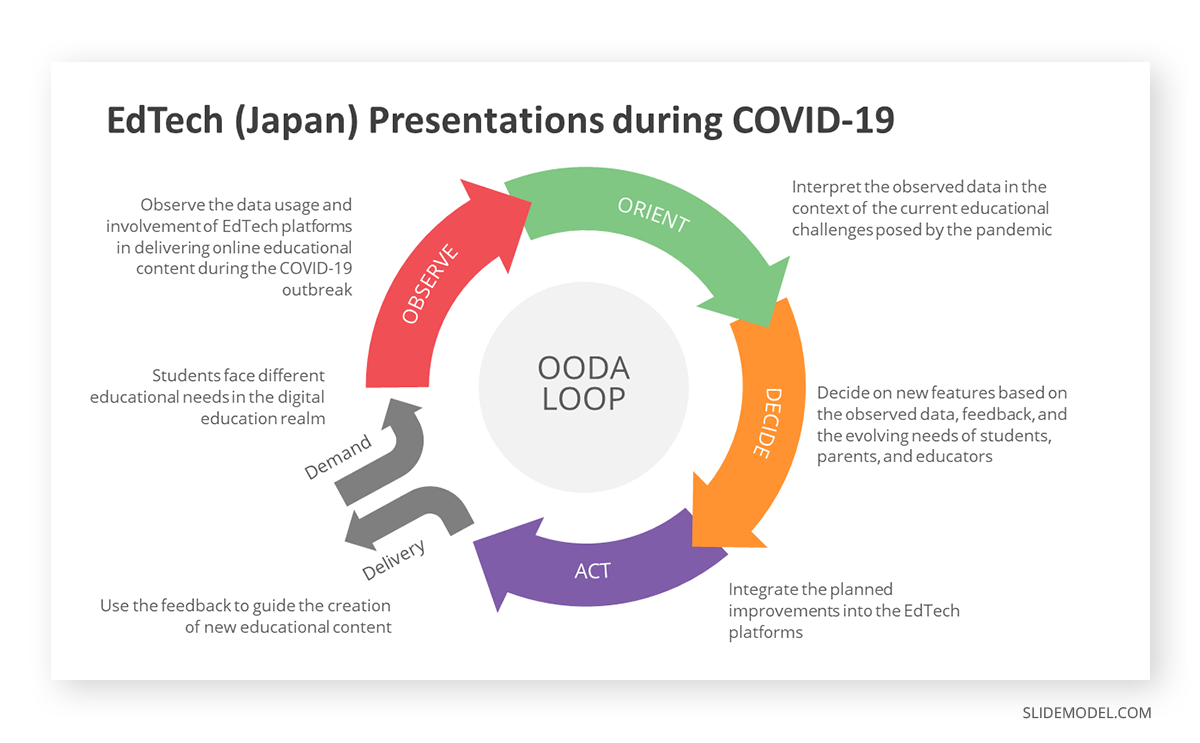
Observe
- Observe the data usage and involvement of EdTech platforms in delivering online educational content during the COVID-19 outbreak [14].
- Gather information on the number of students accessing the material, the length of involvement, and feedback from students.
Orient
- Interpret the observed data in the context of the current educational challenges posed by the pandemic.
- Understand the strengths and weaknesses of the existing EdTech infrastructure.
- Identify areas for improvement based on user feedback and engagement patterns.
Decide
- Formulate a plan to enhance and expand the existing EdTech infrastructure.
- Decide on new features based on the observed data, feedback, and the evolving needs of students, parents, and educators.
Act
- Integrate the planned improvements into the EdTech platforms.
- Use the feedback to guide the creation of new educational content.
Volleyball Coaching Presentations
For those unfamiliar with professional gaming environments, coaches deliver extremely detailed presentations covering all aspects of the team’s performance, which areas to improve, and what they can learn from the rival team. This happens either prior to games against rival teams or during practice sessions when reviewing new strategies. Let’s see how the OODA Loop can help a coach to craft a better presentation.
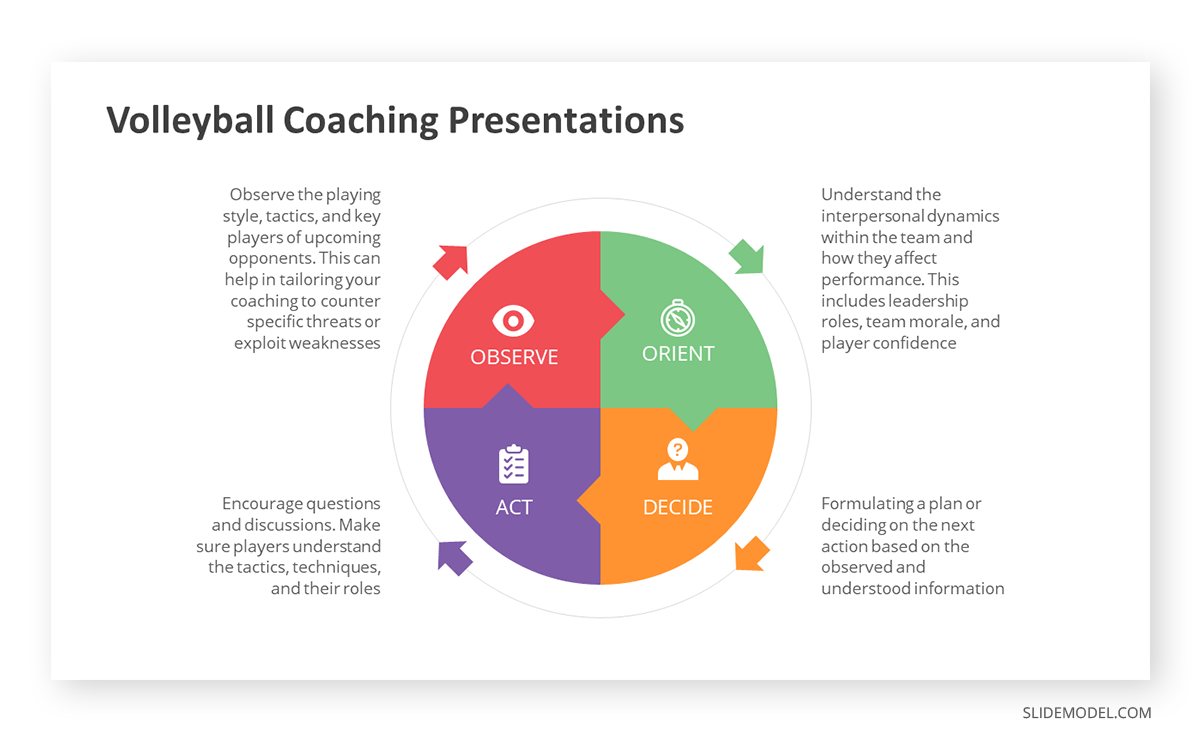
Observe
- Observe the game situation, opponent movements, and ball trajectory [16].
- Coaches emphasize the importance of training players’ vision through visual exercises.
- Observe the playing style, tactics, and key players of upcoming opponents. This can help tailor your coaching to counter specific threats or exploit weaknesses.
Orient
- Focusing attention on the observed information, transitioning from raw sight to understanding the context.
- Acknowledging that a player’s decisions are influenced by a lifetime of training and beliefs.
- Understand the interpersonal dynamics within the team and how they affect performance. This includes leadership roles, team morale, and player confidence.
Decide
- Formulating a plan or deciding on the next action based on the observed and understood information.
- Clearly define what you expect to achieve with the team through this coaching session, setting realistic and measurable goals (better known as SMART Goals).
Act
- Executing the decided action or performing the volleyball skill based on the decision.
- Encourage questions and discussions. Make sure players understand the tactics, techniques, and their roles.
Sales Pitch Presentation to a Potential Customer
A sales pitch is a specific type of persuasive presentation aimed at convincing a prospective buyer to acquire a product or service. It is a key component of the selling process, and the OODA Loop can give a helping hand in crafting better-quality sales pitch presentations.
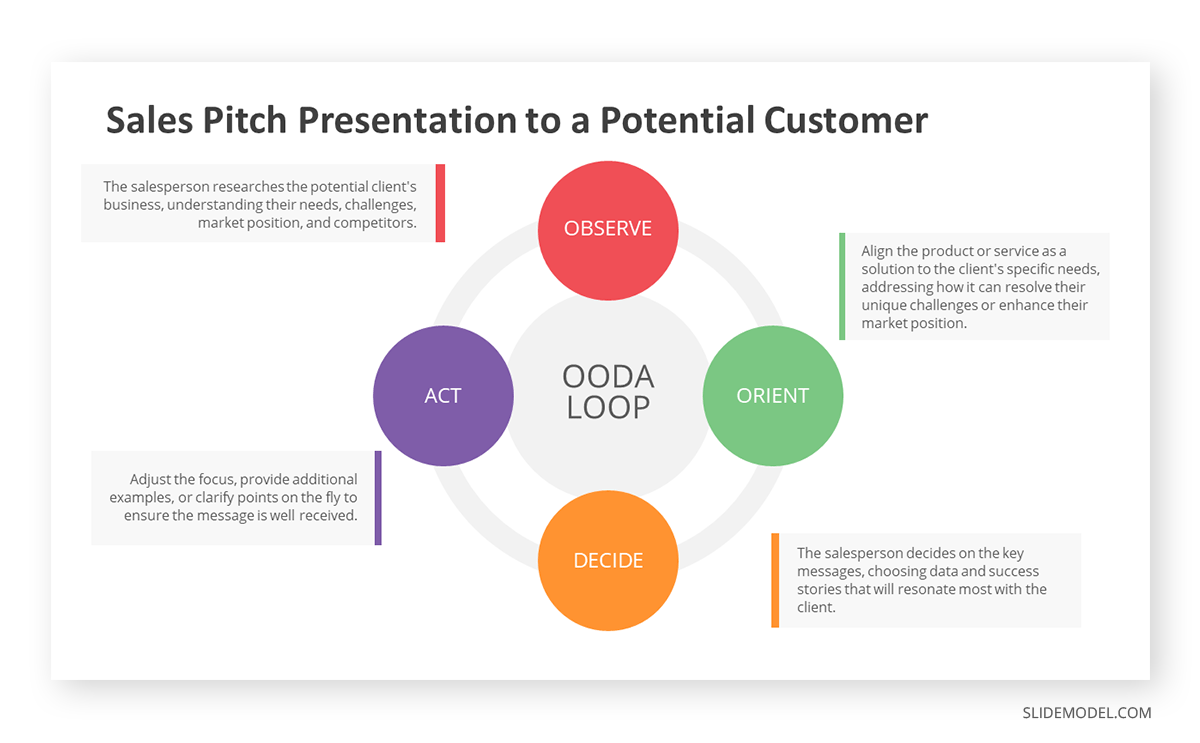
Observe
- The salesperson researches the potential client’s business, understanding their needs, challenges, market position, and competitors. They also gather insights about the client’s decision-makers, including their interests and pain points.
Orient
- Based on this information, the salesperson tailors the pitch. They align their product or service as a solution to the client’s specific needs, addressing how it can resolve their unique challenges or enhance their market position.
Decide
- The salesperson decides on the key messages, choosing data and success stories that resonate most with the client. They also plan how to handle potential objections and questions, selecting the most persuasive and clear way to present their offering.
Act
- During the presentation, the salesperson actively engages with the client, adapting their delivery based on the client’s reactions and feedback. They might adjust their focus, provide additional examples, or clarify points on the fly to ensure the message is well received.
Real-Life Examples of the Usage of the OODA Loop in Business Strategy
Elon Musk’s strategic use of the OODA Loop
Musk applies the principles of the OODA Loop in various scenarios [18].
- Observe: In Elon Musk’s strategic decisions, particularly regarding Dogecoin and Tesla, the “Observe” phase of the OODA Loop is evident. Musk keenly observes the environment, such as noticing the impact of changing the Twitter logo to a Dogecoin-related image and monitoring media responses to his legal actions.
- Orient: The “Orient” phase becomes apparent as Musk orients himself based on the observed information. For instance, he gauges public reactions, assesses media coverage, and aligns his actions with the ongoing narrative, as seen in his timely legal motion amid the Dogecoin controversy.
- Decide: Musk’s decisions, a crucial aspect of the OODA Loop, are reflected in actions like filing a legal motion while facing a lawsuit and criticizing analysts during Tesla’s challenging times. These decisions are made swiftly, disrupting the expected course of events and influencing public perceptions.
- Act: The “Act” phase is evident in Musk’s tangible actions, such as the strategic changes to the Twitter logo, legal maneuvers to counter controversies and public statements that divert attention. These actions are implemented promptly, keeping adversaries balanced and reinforcing Musk’s ability to control narratives.
Honda Vs Yamaha
Honda and Yamaha engaged in a competitive battle for dominance in the Japanese motorcycle market in the 1970s [2]. Honda’s strategy involved introducing 113 new models within 18 months, surpassing Yamaha’s 37 models. This case demonstrates the strategic application of the OODA Loop in gaining a competitive advantage beyond mere tempo.
- Observe: Honda recognized that customers valued newness and freshness, which influenced their buying decisions. This observation set the stage for their competitive strategy.
- Orient: Honda’s strategic orientation was key to its success. They not only understood what customers wanted but also focused on influencing customer preferences. Honda’s motorcycles were positioned as fashionable and attractive, creating a distinct orientation that outshone Yamaha’s offerings.
- Decide: Honda decides to introduce a significant number of new models during the business “war” with Yamaha. This decision wasn’t just about speed. It was a strategic move to stay ahead in the market by continuously adapting to customer preferences and influencing their choices.
- Act: The rapid introduction of 113 new Honda models shows Honda’s swift action. The strategic introduction of these models reflected Honda’s commitment to maintaining a better understanding of the market and staying inside Yamaha’s OODA loop. It wasn’t just about speed but about continuously acting on their evolving understanding of customer preferences.
Common Challenges in Applying the OODA Loop
The effectiveness of the OODA Loop faces several challenges and limitations that organizations need to navigate.
Information Accuracy in Observation
One of the challenges is the OODA Loop relies on accurate and relevant information during the observation phase. In complex situations, information may be incomplete or rapidly changing, which causes problems in accurately assessing the environmental context [20].
Adaptability to Individual Decision-Making Styles
The OODA Loop does not accommodate diverse cognitive styles and decision-making preferences [12].
Continuous Iterations and Resource Demand
The OODA Loop requires constant iterations for effectiveness. The demand for continuous cycles can be time-consuming and resource-intensive.
Applicability in Hierarchical Organizations
The OODA Loop may face challenges in highly structured and hierarchical organizations. Decision-making in such environments is often centralized. Such rigid protocols impede the flexibility emphasized by the OODA Loop for success.
Criticisms and Limitations of the OODA Loop
In his critique, Rieger (2021) highlights cognitive biases in the OODA Loop and their influence on information search, interpretation, and subsequent decision-making [12]. Confirmation bias may arise when an information search revolves around existing beliefs, potentially leading to the neglect or downplaying of conflict [12]. Other biases, such as naïve realism and belief perseverance, can also impact data interpretation within the OODA Loop [12]. While speed is crucial, the continuous nature of the loop may strain organizational resources in fast-paced environments. Moreover, individuals vary in their approach, with some favoring systematic and others relying on intuition and improvisation. The OODA Loop does not universally fit all situations or individuals.
Originating as a military strategy concept, it was crafted for high-stakes situations like aerial combat, prioritizing quick decisions. However, in business decision-making scenarios, it oversimplifies matters, potentially overlooking important factors that demand deeper analysis. Effectively implementing the OODA Loop requires investment in training and practice for decision-makers and organizations. Complete knowledge of the OODA loop is important for high-pressure situations. Training not only fosters clarity about the OODA Loop but also cultivates the essential skills for making informed decisions.
Recommended OODA Loop PowerPoint Templates
Final Words
In practical terms, the OODA Loop method offers a systematic way to approach decision-making in business presentations. By using the OODA Loop, presenters adapt to the environment and make timely decisions. It ensures that these decisions align with evolving circumstances in the dynamic business environment. Overall, the OODA Loop enhances the presenter’s ability to effectively convey their message. Also, check our article about decision-making for business and our collection of decision making PowerPoint templates.
References
[1] Watts, B. and Augier, M., 2022. John Boyd on competition and conflict. Comparative Strategy, 41(3), pp.233-260. https://doi.org/10.1080/01495933.2022.2057733
[2] Pullen, J.B., 2014. The Committee to abolish hell: Strategic Culture, OODA loops, and Decision-making by the US National Security Council during the Bosnian War (Doctoral dissertation, The University of North Carolina at Chapel Hill).
[3] Kelly, M. 2014. The OODA Loop (Observe, Orient, Decide, Act), Applying Military Strategy to High-Risk Decision Making And Operational Learning Processes For On-Snow Practitioners. International Snow Science Workshop, Banff. https://arc.lib.montana.edu/snow-science/objects/ISSW14_paper_P3.45.pdf
[4] Galinec, D. and Macanga, D., 2012. Observe, orient, decide, and act cycle and pattern-based strategy: Characteristics and complementation. In Central European Conference on Information and Intelligent Systems (p. 371). Faculty of Organization and Informatics Varazdin.
[5] Luft, A. 2020. The OODA Loop and The Half Beat. https://thestrategybridge.org/the-bridge/2020/3/17/the-ooda-loop-and-the-half-beat
[6] Galinec, D. and Macanga, D., 2012. Observe, orient, decide, and act cycle and pattern-based strategy: Characteristics and complementation. In Central European Conference on Information and Intelligent Systems (p. 371). Faculty of Organization and Informatics Varazdin.
[7] Canter, J., 2000. An agility-based OODA model for the e-commerce/e-business enterprise. https://www.iohai.com/iohai-downloads/iohai-pdf/agility-based-OODA-model.pdf
[8] Rendle-Short, J., 2016. The academic presentation: Situated talk in action. Routledge. https://www.goodreads.com/book/show/40105710-the-academic-presentation?from_search=true&from_srp=true&qid=jSPGYsNkNL&rank=1
[9] Kuppam, M., 2023. Observability Practice with OODA Principles and Processes. Sch J Eng Tech, 11, pp.302-308.
[10] Ndjock, F.N., 2017. From observation to decision-making: How an information system can improve strategic decision-making. International Journal of Social Science and Technology, 2(2), pp.89-99. https://hal.science/hal-02298822/file/7_March_17%281%29.pdf
[11] O’Brien, F.A. and Meadows, M., 2013. Scenario orientation and use to support strategy development. Technological Forecasting and Social Change, 80(4), pp.643-656. https://oro.open.ac.uk/34413/1/MeadowsOBrienTFSC.pdf
[12] Rieger, T., 2021. Vulnerabilities to Cognitive Biases in the OODA Loop Process.
[13] Higgins, G. and Freedman, J., 2013. Improving decision-making in crisis. Journal of Business Continuity & Emergency Planning, 7(1), pp.65-76.
[14] Kang, B., 2021. How the COVID-19 pandemic is reshaping the education service. The Future of Service Post-COVID-19 Pandemic, Volume 1: Rapid Adoption of Digital Service Technology, pp.15-36. https://www.ncbi.nlm.nih.gov/pmc/articles/PMC7869946/
[15] Volleyball1on1 OODA Loop Volleyball Vision Coaching Blueprint And Vision Training For Sports. https://www.volleyball1on1.com/volleyball1on1-ooda-loop-volleyball-vision-coaching-blueprint-and-vision-training-for-sports-paper/
[16] Galinec, D. and Steingartner, W., 2013. A look at observing, orient, decide and act feedback loop, pattern-based strategy and network enabled capability for organizations adapting to change. Acta Electrotechnica et Informatica, 13(2), p.39.
[17] Angerman, W.S., 2004. Coming full circle with Boyd’s OODA loop ideas: An analysis of innovation diffusion and evolution.
[18] Webb, A. 2023. Elon Musk and the OODA Loop. Bloomberg.https://www.bloomberg.com/news/newsletters/2023-04-05/elon-musk-dogecoin-tesla-and-the-ooda-loop-explained
[20] Bryant, D.J., 2006. Rethinking OODA: Toward a modern cognitive framework of command decision making. Military Psychology, 18(3), pp.183-206.
